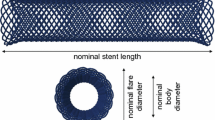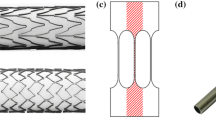Abstract
A problem of random clinical failures of the braided esophageal NiTi stents has been addressed by performing physical simulation experiments on helical NiTi springs loaded in cyclic tension in air, water, and simulated biological fluid. Strains and stresses involved in spring deformation were analyzed through simulation by FEM implemented SMA model. It was found that the fatigue life of NiTi springs is significantly lower in fluids than in the air pointing toward the corrosion fatigue mechanism. There is, however, a fatigue limit roughly corresponding to the onset of martensitic transformation in the wire, which is not common for corrosion fatigue. It is proposed that surface TiO2 oxide cracking plays major role in that. Once the oxide layer on the NiTi wire surface fractures, typically during the first mechanical cycle, cracks in the oxide layer periodically open and close during subsequent mechanical cycling. This leads to the localization of mechanical and corrosion attacks under the oxide cracked regions. Microcracks within the surface oxide layer crossing over into the NiTi matrix were indeed revealed by scanning electron microscopy of FIB sections of fatigued wires. A corrosion assisted mechanism for fatigue crack nucleation at the interface between the surface oxide and NiTi matrix is proposed based on the available evidence. The approach opens a space for a better assessment of the corrosion fatigue performance of superelastic NiTi and ultimately for estimation of the lifetime of implanted braided NiTi stents.












Similar content being viewed by others
References
K. Volenec, On the use of Nitinol in Corrosive Environment in Clinical Practice, Proceedings of SMST, 2013
L. Zhu, C. Trepanier, A.R. Pelton, and J. Fino, Oxidation of Nitinol and its Effect on Corrosion Resistance, ASM Materials & Processes for Medical Device Conference, 2003
A. Undisz, F. Schrempel, W. Wesh, and M. Rettenmayer, In situ observation of surface oxide layers on medical grade Ni-Ti alloy during straining, J. Biomed. Mater. Res. A, 2009, 15, p 88
S.W. Robertson, A.R. Pelton, and R.O. Ritchie, Mechanical fatigue and fracture of Nitinol, Int. Mater. Rev., 2012, 57, p 1–36
Y. Kim and S. Miyazaki, Fatigue Life of Ti-50 at.% Ni and Ti-40Ni-10Cu (at.%) Shape Memory Alloy Wires, Proceedings of SMST 1997, USA, March 1997, p 473–478
A.R. Pelton, V. Schroeder, M.R. Mitchell, X.-Y. Gong, M. Barney, and S.W. Robertson, Fatigue and durability of nitinol stents, J. Mech. Behav. Biomed. Mater., 2008, 1, p 153–164
J. Racek, P. Šittner, L. Heller, J. Pilch, M. Petrenec, and P. Sedlák, Corrosion of NiTi Wires with Cracked Oxide Layer, J. Mater. Eng. Perform., 2014. doi:10.1007/s11665-014-0925-8
S. Shabalovskaya, J. Anderegg, and J. Van Humbeeck, Critical Overview of Nitinol Surfaces and their Modifications for Medical Applications, Acta Biomater., 2008, 4, p 447–467
L. Heller, P. Sittner, J. Pilch, Impact of Heat Effects on Superelasticity, Proceedings of ICOMAT 2008, Wiley, 2013
P. Sedlak, M. Frost, B. Benesova, P. Sittner, and T. Ben Zineb, Thermomechanical Model for NiTibased Shape Memory Alloys Including R-Phase and Material Anisotropy Under Multi-Axial Loadings, Int. J. Plast., 2012, 39, p 132–151
P. Sedlák, M. Frost, A. Kruisová, K. Hiřmanová, L. Heller, and P. Šittner, Simulations of Mechanical Response of Superelastic NiTi Helical Spring and Its Relation to Fatigue Resistance, J. Mater. Eng. Perform., 2014. doi:10.1007/s11665-014-0906-y
B. Reedlunn, Ch. B. Churchill, E.E. Nelson, J.A. Shaw, and S.H. Daly, Tension, Compression, and Bending of Superelastic Shape Memory Alloy Tubes, J. Mech. Phys. Solids, 2014, 63, p 506–537
O.W. Bertacchini, D.C. Lagoudas, and E. Patoor, Thermomechanical Transformation Fatigue of TiNiCu SMA Actuators Under a Corrosive Environment—Part I: Experimental Results, Int. J. Fatigue, 2009, 31, p 1571–1578
M.M. Patel, R.F.Gordon, An Investigation of Diverse Surface Finishes on Fatigue Properties of Superelastic Nitinol Wire, Proceedings of SMST (2006)
C.C. Shih, S.J. Lin, K.H. Chng, Y.L. Chen, and Y.Y. Su, Increased Corrosion Resistance of Stent Materials by Converting Current Surface Film of Polycrystalline Oxide into Amorphous Oxide, J. Biomed. Mater. Res., 2000, 52, p 323–332
Acknowledgments
This research has been supported by the 7RPEU project SMARTNETS (FP7-NMP2010-SMALL-262806) and by the projects P107/12/0800 and P108-12-P111 of the Grant Agency of the Czech Republic. The authors would like to express special thanks to Prof. Jan Van Humbeeck from MTM Department KU Leuven for consultancy a providing access to the FEI SEM facility.
Author information
Authors and Affiliations
Corresponding author
Additional information
This article is an invited paper selected from presentations at the International Conference on Shape Memory and Superelastic Technologies 2013, held May 20-24, 2013, in Prague, Czech Republic, and has been expanded from the original presentation.
Rights and permissions
About this article
Cite this article
Hirmanová, K., Pilch, J., Racek, J. et al. Physical Simulation of the Random Failure of Implanted Braided NiTi Stents. J. of Materi Eng and Perform 23, 2650–2658 (2014). https://doi.org/10.1007/s11665-014-0916-9
Received:
Revised:
Published:
Issue Date:
DOI: https://doi.org/10.1007/s11665-014-0916-9




